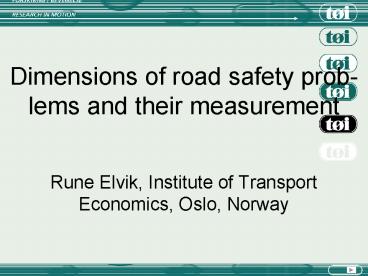Dimensions of road safety problems and their measurement
1 / 31
Title:
Dimensions of road safety problems and their measurement
Description:
Exposure to risk (amount of travel) for each group of road users ... Truck-trailer. Injured in. Counter-part. 22. 23. An example of complexity. 24. 25. 26. 27. 28 ... –
Number of Views:54
Avg rating:3.0/5.0
Title: Dimensions of road safety problems and their measurement
1
Dimensions of road safety prob-lems and their
measurement
- Rune Elvik, Institute of Transport Economics,
Oslo, Norway
2
Levels and objectives of road safety analyses
- International, national, regional or local level
- An applied objective to understand in order to
prevent - Analysis of road safety problems at the national
level for the purpose of developing a road safety
programme
3
Some important questions
- What is a road safety problem? What do we mean by
it? - What is a rational analysis of road safety
problems? - What information is needed to perform a rational
analysis of road safety problems? - What are the basic dimensions of road safety
problems? How can they be assessed?
4
A road safety problem
- Any factor that contributes to the occurrence of
accidents or the severity of injuries
5
Objective of analysis
- To identify those problems that make the
greatest contribution to accidents or injuries
and that are amenable to treatment
6
Elements of a rational analysis
- A taxonomy categorising potential problems
- A method for assessing the size or importance of
problems - A concept of the amenability of problems to
treatment - Access to relevant data
7
Taxonomies 1- The Haddon Matrix
8
Taxonomies 2- Vision Zero
- Inadequate system design (not based on human
tolerance for injury) - Road user vulnerability
- Unsafe road user behaviour (violations)
- Environmental risks
- Inadequate trauma care
9
Taxonomies 3 basic risk factors
- Kinetic energy
- Friction
- Visibility
- Compatibility
- Complexity
- Predictability
- Road user rationality
- Road user vulnerability
- System forgiveness
10
Dimensions of problems
- Magnitude (size of contribution)
- Severity
- Externality
- Complexity
- Inequity
- Spatial distribution
- Dynamics
- Perceived urgency
- Amenability to treatment
11
Measuring dimensions
- Magnitude is indicated by population attributable
risk - Severity is indicated by gradient in relative
risk with respect to injury severity - Externality is indicated by the imposition of
risk by one group of road users upon another - Complexity is indicated by the relative
contribution of specific risk factors to overall
risk
12
Measuring dimensions
- Inequity is indicated by degree of inequality in
risk and lack of proportionality between risk and
benefits of transport - Spatial distribution is indicated by the degree
of geographic concentration of accidents - Dynamics is indicated by trend over time in the
size of a problem
13
Measuring dimensions
- Perceived urgency is indicated by level of
support for interventions designed to solve a
problem - Amenability to treatment is a function of
- Complexity
- Perceived urgency
- Knowledge of effective measures
14
Data that are ideally needed
- Exposure to risk (amount of travel) for each
group of road users - Exposure to specific risk factors (related to a
chosen taxonomy) - Road user behaviour with respect to, for example
speed, seat belt wearing, etc - Injured road users by severity
15
Data needed - continued
- Surveys of perceptions of road safety problems
- A catalogue of potentially effective safety
measures - Preferably time series of data for all items
16
(No Transcript)
17
(No Transcript)
18
(No Transcript)
19
The distribution of risk
20
Three sources of risk
- Internal risk involving members of a specific
group only - Risk imposed by other groups injuries to
members of group 1 in accidents with counterparts
2, N - Risk to other groups (external) injuries to
members of groups 2, N in accidents involving
group 1
21
An example (excerpt)
22
(No Transcript)
23
An example of complexity
24
(No Transcript)
25
(No Transcript)
26
(No Transcript)
27
(No Transcript)
28
(No Transcript)
29
Limitations of analysis
- Biased and incomplete accident reporting
- Availability of data (distractions, fatigue)
- Choosing the right level of analysis
- Possibility of statistical analysis (violations
of expectations) - Treatment of correlations between problems
30
Some observations
- A comprehensive analysis of road safety problems
is needed to develop effective road safety
programmes - The analysis of road safety problems is complex,
as these problems are multi-dimensional - Analysis should start by choosing a taxonomy to
help classify problems
31
Further observations
- A list of potential problems in each category of
the taxonomy should be made - The dimensions of problems to be emphasised in
analysis should be chosen - Create profiles of problems
- Determine promising targets for intervention
based on these profiles































